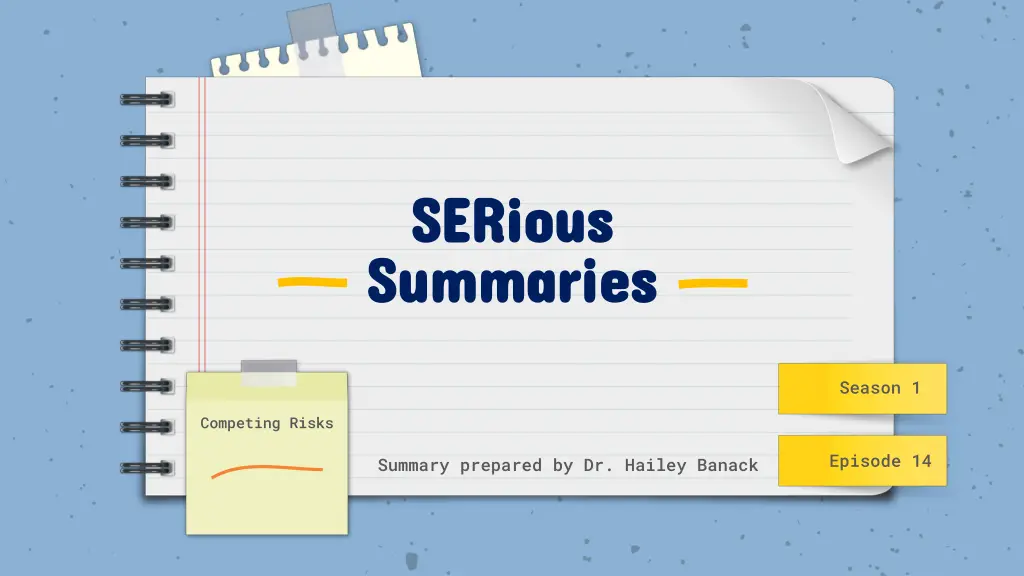
Understanding Competing Risks in Studies
Discover the importance of accounting for competing risks in research studies to avoid erroneous inferences. Dr. Bryan Lau sheds light on the significance of competing risks and the necessity of proper modeling for accurate results. Learn how competing risks regression plays a crucial role in valid inference and risk assessment.
Download Presentation

Please find below an Image/Link to download the presentation.
The content on the website is provided AS IS for your information and personal use only. It may not be sold, licensed, or shared on other websites without obtaining consent from the author. If you encounter any issues during the download, it is possible that the publisher has removed the file from their server.
You are allowed to download the files provided on this website for personal or commercial use, subject to the condition that they are used lawfully. All files are the property of their respective owners.
The content on the website is provided AS IS for your information and personal use only. It may not be sold, licensed, or shared on other websites without obtaining consent from the author.
E N D
Presentation Transcript
SERious SERious Summaries Summaries Season 1 Competing Risks Episode 14 Summary prepared by Dr. Hailey Banack
Its Always a Competition: Competing It s Always a Competition: Competing Risks with Dr. Bryan Lau Risks with Dr. Bryan Lau Do you, like us, understand that competing risks are important to account for and yet are not 100% sure exactly what they are and when they matter? Do you stay up at night wondering if competing risks regressions are necessary for valid inference in your study? If so, this episode is for you. Dr. Bryan Lau gives us the details on this important method.
S1 E14 Episode Notes Episode Notes
Competing risks are situations where multiple potential outcomes are possible, but the occurrence of one event prevents another. Ignoring competing risks in studies can lead to incorrect inferences, often overestimating the risk of the primary event.
Competing risks: Competing risks: When you have a setting with competing risks -As an example, imagine you are following individuals over time for cardiovascular disease mortality, but death from other causes (e.g., cancer) precludes this event The cause- specific hazard model can account for both the event of interest and competing events to provide correct results -Competing risks need to be considered in time-to-event analysis to accurately model and interpret the risk of the event of interest -Traditional models often censor individuals at the time of a competing event, which can lead to misinterpretation of risk. Correctly interpreted, the cause-specific hazard ratio represents the force of the event of interest, considering the competing events. -Confusion in the literature exists, with some believing they can ignore competing risks by just censoring, leading to incomplete models.
Analogy: Multi Multi- -state models state models Consider the concept of forces acting on an individual akin to soccer players influencing the direction of a ball This helps visualize how hazards operate at any given time Treats each possible state transition (e.g., from healthy to disease or death) as part of a comprehensive model Statistical methods that simplify the complex real-world scenario into manageable states and transitions. -Both the event of interest and competing events need to be modeled to accurately reflect the real-world scenario. Move towards more complex and realistic modeling of health states and outcomes, considering the broader system of influences. -Researchers must consider how an exposure affects both the event of interest and competing events to avoid misleading conclusions.
Relating competing risks to the counterfactual framework involves recognizing that ignoring competing events is ignoring potential outcomes and their influences on the event of interest Researchers need to consider all potential outcomes and what might prevent participants from experiencing the event of interest
Competing risks with RCTs In RCTs, potential outcomes are considered before randomization, including competing events such as death Competing events like death can preclude the primary event of interest, such as hospital discharge. Researchers need to consider all possible outcomes and what might prevent participants from experiencing the event of interest. Composite outcomes in trials attempt to address this issue but can obscure specific effects. Ignoring competing risks still involves a decision-making process and has implications. Ignoring competing risks by treating them as censored assumes continuity of risk, which may not reflect reality.
Competing risks Competing risks models models Competing risks are not merely a missing data problem but reflect real-world complexities that need to be addressed directly. Partition individuals into different event outcomes, addressing the reality of multiple possible outcomes Sub-distribution hazards maintain individuals with competing events in the risk set to estimate their effect Competing risks provide insights into the complexity of health outcomes and the importance of considering multiple influences. Different models like cause-specific hazards and sub-distribution hazards answer different research questions. Using both cause-specific hazards and sub-distribution hazards will provide a full understanding Properly addressing competing risks requires understanding the different interpretations of hazard ratios and their implications.
References discussed in this episode: References discussed in this episode: 1. Koller MT, Raatz H, Steyerberg EW, Wolbers M. Competing risks and the clinical community: irrelevance or ignorance? Stat Med. 2012 May 20;31(11- 12):1089-97. 2. Andersen PK, Geskus RB, de Witte T, Putter H. Competing risks in epidemiology: possibilities and pitfalls. Int J Epidemiol. 2012 Jun;41(3):861- 70. 3. Allignol A, Schumacher M, Wanner C, Drechsler C, Beyersmann J. Understanding competing risks: a simulation point of view. BMC Med Res Methodol. 2011 Jun 3;11:86. 4. Grambauer N, Schumacher M, Dettenkofer M, Beyersmann J. Incidence densities in a competing events analysis. Am J Epidemiol. 2010 Nov 1;172(9):1077-84. 5. Lau B, Cole SR, Gange SJ. Competing risk regression models for epidemiologic data. Am J Epidemiol. 2009 Jul 15;170(2):244-56.
Acknowledgements Co Co- -hosts: hosts: Hailey Banack, Matt Fox Special guest: Special guest: Bryan Lau Mahrukh Abid (UofT) Sue Bevan (SER)
